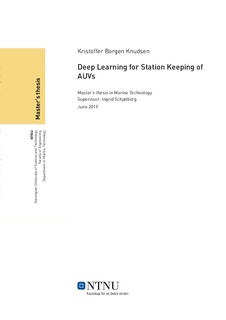| dc.description.abstract | Denne oppgaven undersøker mulighetene for å anvende maskinlæring, mer spesifikt dyp læring, for å holde et autonomt undervannsfartøy i en fast ønsket posisjon (eng: station keeping). Dette er en videreføring av forarbeidet som ble gjort av Knudsen på temaet [10].
Bruken av dyp læring i denne oppgaven omhandler utviklingen av et tilstrekkelig kontrolldesign for å oppnå station keeping, som betyr at fartøyet holdes konstant i alle seks frihetsgrader (6-DOF, eng: six degrees of freedom). Station keeping egenskaper er ekstremt viktig for å kunne gjennomføre undervannsoperasjoner effektivt. Undervanns kontrolldesign er komplisert, noe som er mye grunnet det komplekse undervannsmiljøet. Miljøet resulterer i ikke-lineær kontroll siden fartøyet er sensitiv til strømning og hydraulisk motstand. Dette gjør at klassiske model-baserte kontrolldesign er vanskelig å anvende. Disse vanskelighetene, sammen med den raske utviklingen som har vært i kunstig intelligens, har skapt en stor interesse rundt mulighetene for å bruke maskinlæringsteknikker i undervanns kontrolldesign.
For å utvikle samt trene en kontroller basert på maskinlæring for station keeping brukes en dynamisk modell av en BlueROV2, som er et lite fjernstyrt undervannsfartøy. Fartøyet blir kontrollert i 6-DOF ved å foreslå bruken av et todelt kontrolldesign som består av en Deep Deterministic Policy Gradient (DDPG) algoritme og en Proportional-Derivative (PD) kontroller. For å trene kontrolleren brukes to simuleringsmiljøer, Gazebo og Robot Operating System (ROS), sammen med maskinlæringsrammeverket TensorFlow. I simulering har BlueROV2en ikke en fysisk tilkobling til en operatør, noe som gjør at det er antatt at den opptrer som et autonomt undervannsfartøy.
Resultatene fra simulering viser at det er mulig å tilstrekkelig trene en maskinlæringsalgoritme for å oppnå station keeping i 6-DOF. Dette blir gjort ved å bruke DDPG algoritmen til å kontrollere thrust bidraget i jag x og svai y, og PD kontrolleren til å kontrollere thrust bidraget i hiv z, stamp φ, rull θ og gir ψ. Ved å validere resultatene viser det seg at station keeping blir oppnådd med avvik i størrelsesordenen 0.01 meter i simulering og 0.1 meter for det virkelige systemet. Hovedgrunnen til forskjellene er at den dynamiske modellen ikke er helt eksakt samt mangler i det virkelige posisjonssystemet.
Arbeidet med denne oppgaven har også resultert i et abstract til IEEE Oceans 2019 konferansen i Seattle. Bidraget finnes i Appendix B. | |
| dc.description.abstract | This thesis investigates the possibilities of applying machine learning techniques, more specifically deep learning, in station keeping of autonomous underwater vehicles, and it is a continuation of the preliminary work done by Knudsen [10].
The usage of deep learning in this thesis surrounds the development of a sufficient controller design to accomplish station keeping, meaning that the vehicle is kept stable in all six degrees of freedom (DOF), which is fundamental for performing underwater operations efficiently. The process of doing underwater control design is complicated, which is mainly due to the complex underwater environment. The environment makes the control nonlinear since the vehicle is sensitive to flow and hydraulic resistance. In turn, the classical model-based approaches become challenging to apply. These disadvantages, together with the rapid developments in artificial intelligence (AI), have triggered the interest of using machine learning (ML) techniques in underwater control designs.
To develop and train an ML-based controller for accomplishing station keeping, there is used a dynamic model of the BlueROV2, which is a small, remotely operated vehicle. The vehicle is controlled in all 6-DOF, trough suggesting the use of a dual control design which encompasses a Deep Deterministic Policy Gradient (DDPG) algorithm in conjunction with a Proportional-Derivative(PD) controller. To sufficiently train the algorithm, two simulation environments, Gazebo and Robot Operating System (ROS), are used in combination with the machine learning framework TensorFlow. In the simulated environment, the BlueROV2 dynamic model is not connected by a tether, and is therefore assumed to behave as an autonomous underwater vehicle.
The simulation results shows that it is possible to sufficiently train a machine learning algorithm to accomplish station keeping at an arbitrary pose, in all 6-DOF. To accomplish this the dual control design splits the fully actuated BlueROV2 by using the DDPG algorithm to control the thrust input in surge x and sway y, and the PD controller to control the thrust input in heave z, pitch φ, roll θ and yaw ψ. Validation of the results shows that the vehicle accomplishes station keeping with error values in the order of 0.01 meters in simulation and 0.1 meters in real-life experiments. The main reasons for the differences are flaws in the dynamic model used in training, as well as weaknesses related to the real-life pose measurement equipment.
The work in this thesis has also resulted in an abstract submitted to the IEEE Oceans 2019 conference in Seattle, which is given in Appendix B. | |
